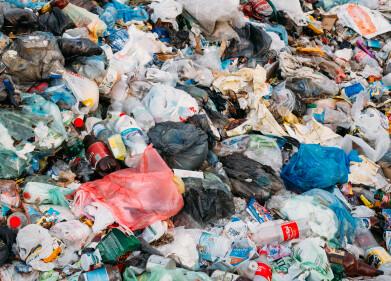Microplastics Analysis
Is solvolysis the key to advanced recycling of plastics?
May 05 2024
Solvolysis is a critical chemical process that involves the breakdown of chemical compounds by reaction with a solvent. In the context of plastic recycling, solvolysis refers specifically to the chemical recycling methods that deploy solvents to depolymerize plastics back into their constituent monomers or other useful chemicals. Let’s explore the mechanisms of solvolysis, its application in advanced recycling technologies, and its potential impacts on the sustainability of plastic manufacturing and waste management.
Solvolysis is a reaction where a solute is decomposed or reacted due to a solvent, often in the presence of a catalyst. The most common form of solvolysis is hydrolysis, where water serves as the solvent. However, other solvents like alcohols (alcoholysis), acids (acidolysis), and bases (basolysis) can also induce solvolysis. In the chemical recycling of plastics, solvents are carefully chosen based on the type of plastic and the desired reaction pathway. For example, polyethylene terephthalate (PET) can be depolymerized into terephthalic acid and ethylene glycol through glycolysis, where ethylene glycol acts both as a solvent and a reactant.
Advanced recycling, sometimes called chemical recycling, aims to convert waste plastics into virgin or near-virgin quality materials. This is distinct from mechanical recycling, where physical processes are used to reclaim plastics, often resulting in lower-quality materials due to polymer degradation. Solvolysis emerges as a pivotal technology in advanced recycling due to its ability to break polymers down into their monomers, which can then be repolymerized into high-quality plastics. This method not only recycles plastic but does so in a way that the end product can meet the stringent quality requirements for use in consumer goods, packaging, and even in medical applications.
Implementing solvolysis in plastic recycling involves several critical steps. First, the selection and preparation of the solvent, which must be capable of reacting with the polymer in question. Solvents are chosen based on their ability to break specific chemical bonds within the polymer structure. Then, conditions such as temperature, pressure, and time are optimized to maximize yield and efficiency. Catalysts are often employed to lower the activation energy of the reaction. Following solvolysis, the monomeric products are separated and purified from the reaction mixture, which may contain solvent, unreacted polymer, and byproducts. Finally, the purified monomers are then polymerized to form new plastics. This step is crucial as it determines the properties of the recycled plastic.
Solvolysis holds several advantages over traditional mechanical recycling. Solvolysis can potentially restore plastics to their original monomeric forms, allowing for the production of high-quality materials that are indistinguishable from virgin plastics. It can be applied to a variety of polymers that are not typically recyclable through mechanical means, such as multilayer films and heavily contaminated plastics. By diverting plastics from landfills and reducing the need for virgin material production, solvolysis can significantly decrease the environmental footprint of plastic products.
Despite its advantages, solvolysis is not without challenges. The process requires high energy inputs and often uses expensive and potentially hazardous solvents. The economic viability of solvolysis depends on the scale of operations, efficiency of the process, and market demand for recycled plastics. Additionally, the handling and disposal of byproducts and residual waste materials pose environmental and safety concerns.
To overcome these challenges, ongoing research focuses on developing more efficient catalysts, greener solvents, and processes that operate under milder conditions. Another area of research is the design of novel polymers that are easier to recycle through solvolysis, aiming to make plastics circular by design.
Solvolysis represents a promising avenue for advancing the sustainability of plastics through recycling. By enabling the conversion of waste plastics back into high-quality raw materials, solvolysis not only supports the circular economy but also mitigates the environmental impacts associated with plastic waste. As research progresses and technology matures, solvolysis could become a cornerstone of modern waste management and material recovery systems.
Digital Edition
IET 34.2 March 2024
April 2024
Gas Detection - Biogas batch fermentation system for laboratory use with automatic gas analysis in real time Water/Wastewater - Upcycling sensors for sustainable nature management - Prist...
View all digital editions
Events
May 20 2024 Columbus, OH, USA
May 21 2024 Lagos, Nigeria
May 23 2024 Beijing, China
May 23 2024 Beijing, China
May 29 2024 Beijing, China



















